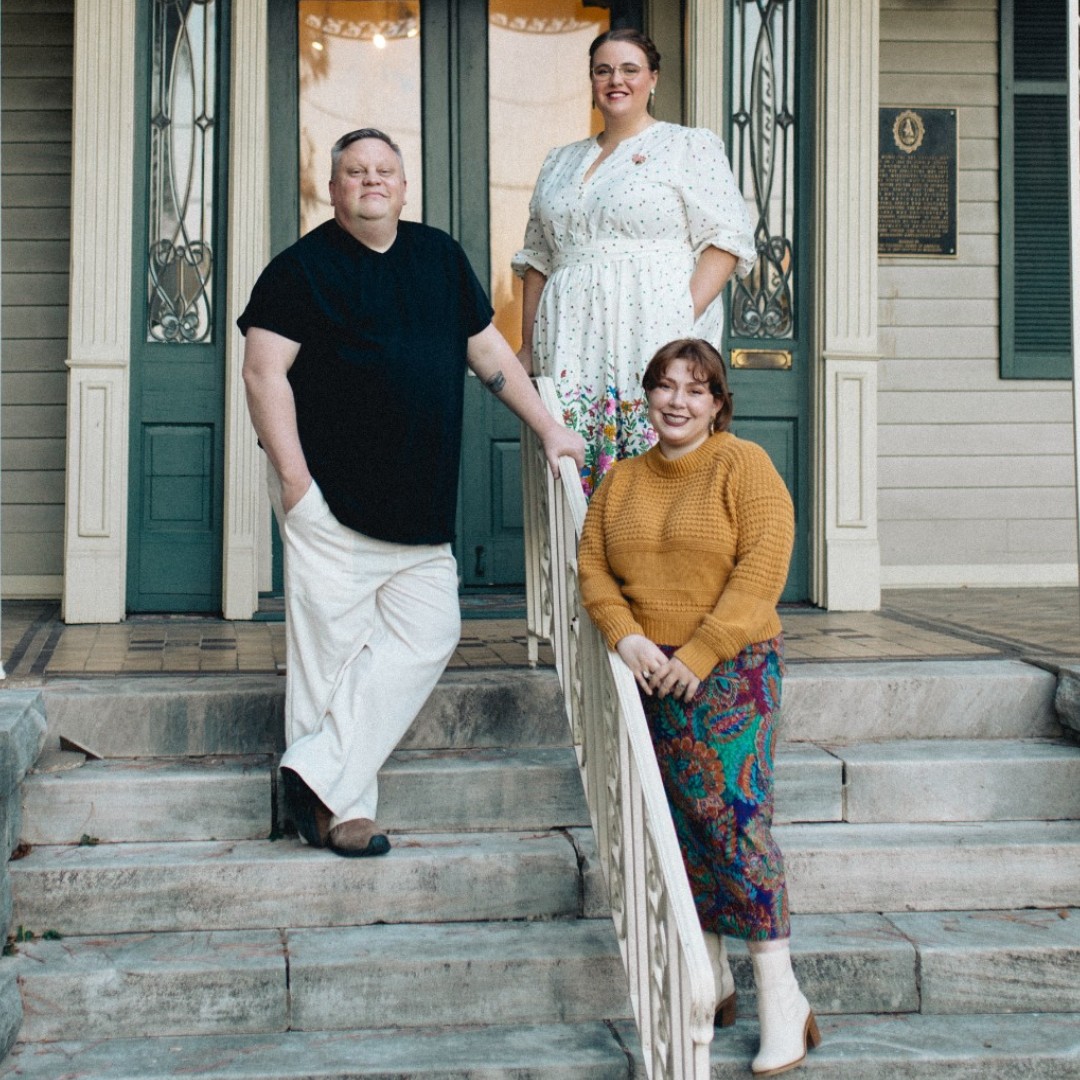The Rush to Archive America’s Diversity Programs
How an Alabama-based nonprofit and its team of volunteers is preserving decades of digital history
By Caroline McCoy

From left to right: Joshua Burford, Maigen Sullivan, and Margaret Lawson, courtesy of Invisible Histories
On the evening of January 17, at six o’clock Central Time, volunteers for Invisible Histories, a community-based and South-centered queer archive, began logging on to Zoom. They had been called there by Maigen Sullivan and Joshua Burford, the founders and co-executive directors of Invisible Histories, who were concerned about the future of digital LGBTQ+ records that were controlled or influenced by government funding. The incoming administration had made ending government-funded diversity initiatives a campaign promise, and Sullivan and Burford anticipated that the resources related to those initiatives would be targeted for removal from public access. Their solution was to organize a hackathon, where volunteers would proactively preserve the digital footprints associated with at-risk LGBTQ+ programs. The event required tech-savvy volunteers to spend the next two hours downloading relevant website content and uploading it to a shared drive for Invisible Histories to process. Sullivan and Burford told their volunteers that they were engaged in “hands-on guerrilla archiving,” a description that conveyed a sense of urgency that would only increase in the coming weeks.
In 2018, when Sullivan and Burford founded Invisible Histories in Birmingham, Alabama, their mission was to collect, preserve, and promote access to Southern queer history. But since that mid-January hackathon—amid a flurry of executive orders directed at eliminating DEI initiatives on college campuses and a mid-February notice from the U.S. Department of Education that noncompliant institutions would lose federal funding—Sullivan and Burford have stepped into new territory. “We have had to start collecting things that are quite a bit outside of our scope,” Sullivan said. “We’re calling it queer adjacent.” In the weeks since that first hackathon, Invisible Histories has expanded from a repository for southern LGBTQ+ history to a safe haven for materials from any closing diversity, equity, inclusion, and accessibility office in the country. The nonprofit organization purchased a fifty-terabyte server to store and backup digital materials and began hosting additional hackathons focused on DEI office closures. So far, volunteers have helped preserve roughly twelve hundred websites, downloading close to three thousand photos, flyers, and images before they could be wiped from institutional memories. Amid uncertainty about funding streams for research grants, Invisible Histories is also backing up federally funded research.
The organization’s plan to expand its preservation focus emerged from watching anti-DEI legislation take root, first, in Southern states. In 2023 and 2024, Alabama, Florida, North Carolina, Tennessee, and Texas targeted diversity programs at public universities. Offices designed to assist students of color, international students, and LGBTQ+ students closed without warning and sometimes preemptively—before legislation was enacted—thwarting opportunities for faculty and students to restructure to remain compliant with changing state laws. Sullivan and Burford had learned about websites being pulled down, university staff being locked out of their accounts, and documents being thrown in dumpsters. “All the things that are happening on the federal level have been happening, particularly in the Deep South, for a long time now,” Sullivan said.
In one instance, a leadership program established to support and retain Black male students at a state university shuttered within months of a major fundraising campaign to establish a scholarship. According to the former director of the program, who spoke with the Oxford American on the condition of anonymity, the university failed to inform at least some scholarship benefactors that the associated program had been dissolved. “If people give money to a specific initiative, and you are planning on redirecting the money, you have to let the donors know,” the former program director said. “They did not want to let us know.”
Failures of communication abound in stories about the dismantling of DEI initiatives in higher education. For the former director of the Black men’s program, the confusion caused by silence from university leadership seemed like the point. Had the university prepared students and faculty for the program’s closure, she said, “there would have been strong pushback. Or we would have said, ‘We understand it’s law. Can we . . . start having meetups to talk about how we could pivot so that students don’t lose these resources?’” She believes that the university’s decision to prevent organized discussion—to keep the program’s closure quiet and unceremonious—was tied to an institutional desire to avoid public accountability and minimize any potential impact on its endowment.
The program was dissolved seemingly overnight. Its page on the university website was taken down. Employees were shuffled into new positions. Someone threw everything from the office in the garbage. Decades of student achievements, awards, training manuals, workshop plans, alumni lists, T-shirts, pins, graduation stoles, documents related to service projects and internships—all of it was gone. “There’s nothing left,” the former director said.
The impact of the program on its members had been substantial. Black male students felt supported by a community rooted in acceptance and by resources that were uniquely matched to their needs, including mentorship by upperclassmen and an engaged alumni network that provided professional guidance. The program had been created to help its members recognize and reach their potential; and it had worked, gaining such strong recognition in higher-ed circles that other universities began using it as a model in their own efforts to support historically marginalized students. Preserving the program’s legacy and the years of work that built it would have been as simple as relocating materials to the university archive on campus, said the former director. Instead, she said, the university “worked to erase something that was so important to generations of Black men.”
The rate at which Invisible Histories is collecting DEI materials reflects how quickly diversity programs are being erased on college campuses. “We knew it was going to happen,” Burford said. “We just were not prepared for the speed. I don’t think anybody was.” Lately, he has been receiving urgent requests for help relocating materials. “We’ve had . . . people saying, ‘I don’t think this is going to be around on Friday, and so we have to do something today. . . . It’s been an avalanche the last couple of weeks,” Burford said. To help manage this influx, the organization is only accepting physical materials from the thirteen Southern states that compose their primary region of focus, while providing digital preservation for any diversity program in the nation.
In archival speak, “processing” all of these materials means assessing each artifact, describing it, and organizing it in the context of a collection so that it can be easily found and accessed by researchers. Once a collection has been processed, archivists create a finding aid to further help researchers understand and navigate the collection’s contents. Burford said that Invisible Histories has processed eight collections already and is working on processing dozens more. (To protect the university staff, students, and faculty they have been collaborating with, Burford and Sullivan said that they would not release information about any DEI-related materials they’ve collected until they deem it safe to do so.)
Processing a single collection is a methodical and time-consuming exercise, which is not a problem for archivists under usual circumstances. But Invisible Histories is no longer operating under usual circumstances. Rather, the organization has found itself performing the kind of rapid response collecting often associated with historic moments of crisis, when archivists actively seek out and preserve for posterity the ephemera that reflects the time. (During the early days of COVID, archivists practiced rapid response collecting.) Invisible Histories has even created guides for documenting protests to aid volunteers who want to engage in contemporaneous record-keeping. In this way, Burford and Sullivan are not just preserving the legacies of diversity programs; they’re also preserving a contemporary landscape of anti-DEI policies and a widespread acceptance of those policies by the nation’s universities. “There’s a huge, huge problem at our institutions,” Sullivan said. “We can’t pretend like they’re victims. They’re not victims, they’re enablers.” Oftentimes, she said, university systems are “the number one economic engine in a state, and [they’re] just rolling over like [they] have no power.”
As Invisible Histories rushes to preserve decades of diversity programming, the organization is also focused on mitigating risks to existing archival collections, which have earned more attention in recent months. In late October of 2024, the Wall Street Journal reported that the country’s lead archivist, Colleen Shogan, had removed troubling aspects of American history—including the forced displacement of indigenous tribes and the internment of Japanese citizens—from exhibitions at the National Archives. (Shogan was dismissed from her position in February, along with thousands of other federal workers.) More recently, the National Park Service removed references to transgender people from its official Stonewall National Monument website. The move aligned not with historical fact but with a January 20 executive order that rescinded federal recognition of transgender people. “The mass editing of archival collections is on the horizon,” Burford said. “It’s already happening.”
He and Sullivan said that some university archivists had contacted them after high-level administrators requested information about the topics contained within their collections. Such requests have alarmed the researchers and staff who work in archives, which have generally avoided the anti-DEI scrutiny and public calls for censorship that have plagued public libraries in recent years. Sullivan said that national conversations about which books are circulating in public libraries would likely begin to encompass archival holdings. “[Libraries are] a non-capitalist form of social sharing that we have in this country that is federally funded,” she said. “I think once people realize that archives work very similarly . . . that [they] might come under similar attacks.”
To help protect existing collections from comparable forms of suppression, Invisible Histories launched an emergency loan program earlier this year. If any library archive holds LGBTQ+ or adjacent collections that are at risk of being censored, destroyed, or deaccessioned, the organization will keep the materials until it is safe to send them back to their original institution. One university professor and researcher, who spoke with the Oxford American on the condition of anonymity, has been working on a years-long oral history project that documents decades of LGBTQ+ life in her small Southern community. Initially, she worked with her university’s archive to store materials from the project. Recently, though, she began donating her work to Invisible Histories because she believes her research will be best preserved by an archive that does not receive government funding. Public universities and libraries, she said, “can only ensure the safety of our material so far. When you’re dependent on federal and state funding, then you have to comply.” (To date, the university maintains control over the material the professor donated prior to her decision to work with Invisible Histories.)
The professor, a teacher of gender and sexuality studies and a faculty advisor for the university’s LGBTQ+ student organization, said her decision to move the oral history collection away from her university coincides with recent actions by school administrators. “Several months back,” she said, “I was invited to think of a new name for my department that wouldn’t involve gender or sexuality in the title. . . . We’ve been encouraged to think carefully about the language we use to describe our classes.” She said that a course about fascism was now being offered under a new name that did not include the word “fascism.” Last fall, the university closed its office of multicultural affairs, firing the staff.
The most recent blow arrived in late February. Two days before she spoke with the Oxford American, the professor received word that the building that served as the meeting place and offices for LGBTQ+ and BIPOC student groups was being repurposed by the university. Immediately, she alerted the students, who had not been told that their center of operations would be shuttered. The space had been created, she said, to support marginalized groups. It represented a legacy of students and faculty who protested and fought for their right to exist on the university’s campus. Now, students were required to negotiate the retrieval of their belongings with campus police. “I went that day and got everything out of there,” the professor said. “I don’t trust anyone.”
Editorial disclosure: The author has volunteered with Invisible Histories on an unrelated project.




